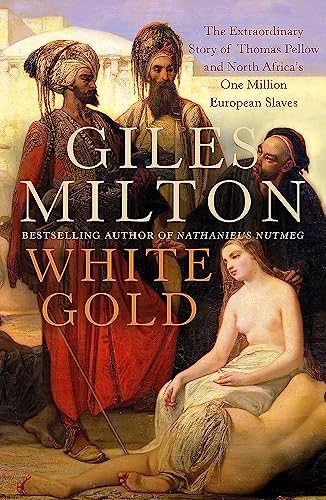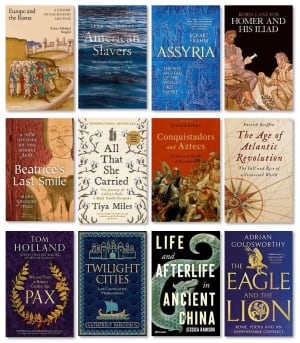Dressed in Moorish djellabas and wielding damascene scimitars, they made a terrifying sight as they burst into the parish church.
The 1625 Moroccan raid on the Cornish village of Mount’s Bay was a complete success as “sixty men, women and children were dragged from the church and back to the corsairs’ ships.” The hit and run slave raiding fleet from North Africa had even managed to seize Lundy Island in the Bristol Channel which they were using as a summer base for their raids along the coast.
With the English navy completely ineffectual against the fast moving corsair ships, when the summer was over they sailed back to their base on the Atlantic coast with an estimated 1,000 English villagers to be sold as slaves, most of whom would never see their homes again.
What’s in the book?
White Gold: The Extraordinary Story of Thomas Pellow and North Africa’s One Million European Slaves tells the tale of Europeans enslaved by North African states in the 17th and 18th centuries, focussing on the particular case of Thomas Pellow who was captured at the age of twelve in 1716 and eventually made his escape at the age of 34, after twenty three years.
It is a real page turner - I finished it in a few days while waiting for various aeroplanes on my way back to the UK from holiday when I didn’t want anything too heavy to read, but was still in the mood to learn something new.
Perilous pilchards
Pellow’s story is remarkable: captured while returning to the UK from his own trip on his uncle’s boat (selling Cornish pilchards in Genoa), they were almost back home in Cornwall when they were ambushed by Moroccan pirates. With only eight people on board they didn’t stand a chance and were promptly chained up and whisked away to the port of Salé on the north African coast.
His fellow captives were set to work building Sultan Moulay Ismail of Morocco’s huge palatial complex in Meknes, in appalling conditions. Most would die there including his uncle. Pellow was lucky because he was picked out by the Sultan as suitable palace slave material - possibly because he was seen as young and therefore malleable.
There no god but God
Sent to serve one of the Sultan’s many sons he was tortured for months to make him convert to Islam. After beatings, starvation, and burnings Pellow could stand it no longer and submitted.
Recognised as a bright and promising young lad he was eventually promoted to be a doorman for the Sultan’s harem, where his job was basically not to let anyone in, ever.
Too close for comfort
Because he was close to the centre of power he witnessed first hand the brutality and ruthlessness of Sultan Moulay Ismail - who ruled Morocco for an incredible 55 years, from 1672 to 1727. Milton summarises thusly:
In the course of his reign, he had overseen the deaths of thousands of men and women, a number of whom had been butchered by his own hand. He had ordered countless courtiers to be dragged behind mules until they were dead and had slain dozens of his imperial guard. Several of his sons had been put to death, and he had maimed and mutilated many of his wives. At least two of his subjects had been sawn in two, and numerous kaids and officers had lost eyes and limbs. But Moulay Ismail reserved the greatest contempt for his slaves, who had been butchered and tortured, mutilated and broken.
Giles Milton, White Gold
Pellow was then married off by the Sultan and turned into a somewhat reluctant soldier. After joining a number of different campaigns, including a massive 30,000 strong expedition across the Sahara to capture black African people as slaves - they were to be turned into the elite core of the Sultan’s army - Pellow made his successful escape.
In the meantime his wife and then ten year old child had sadly died and he had had two failed escape attempts, both of which very nearly ended in his own death.
A life of toil
Pellow was lucky to survive, lucky to get back home, and lucky to avoid the hardships of most of his other fellow European slaves. For those who refused to convert to Islam life was unremitting toil on starvation rations in the full heat of the sun, with constant beatings and frequent illness - which killed many of them after a few years in captivity.
It’s all about England
This book shines a light on the experiences of some tens of thousands, or possibly hundreds of thousands of European slaves in North Africa over a period of 200 years. But it doesn’t really illuminate North Africa itself very clearly. It is more a book about 17th century English and European attitudes and worldviews than it is about Morocco.
For example, Sultan Moulay Ismail is presented as a cartoon monster, where pretty much every description of him is pejorative. Of his birthplace Milton writes:
The natives of this dusty backwater scratched a living as best they could but remained a ‘wild savage and cruel people’
I think what he is getting at is that they were poor.
When talking about his principle wife Milton is even more severe:
Lala Zidana... was, by all accounts, a veritable harridan, ‘black, and of a monstrous height and bulk’, wrote Father Busnot in 1714. She had beady eyes and an elephantine belly...
Whether or not she was a cruel person this description appears to be just parroting a racist 17th century European perspective.
Even the Sultan’s potentially positive traits are tainted: rather than a pious Muslim he is described as a ‘fervent’ believer.
More than just a monster?
The upshot is that we don’t get any indication of why he was so successful and ruled for so long, other than that he used his slaves as a force to maintain power - which can’t be the whole story.
The Sultan’s main role in this book is to be the bad guy - this helps the narrative along but at the expense of understanding what was really going on.
Normalising slavery?
The other potentially difficult aspect of this book is the juxtaposition of white European slavery and black African slavery. Milton is obviously aware of this potential for contrast (he wouldn’t have called the book White Gold if not) and notes that Black African slavery was a different and worse phenomenon both in terms of quantity and quality.
But the fact that he frequently emphasises the (genuinely terrible) suffering of European slaves and that he emphasises the fact that their overseers were black1 invites the false “everyone was doing it” ‘contextualisation’ of the black African slave trade2, and de-emphasises the fact that these “black slave-drivers” were themselves slaves, taken as children and deliberately brutalised by the Sultan’s regime.[^3]
How much should this matter? Is the fact that it was written 20 years ago in 2004 relevant? I don’t know really - and Milton obviously can’t be held responsible for readers contorting his book to suit themselves. But I do feel that, for the sake of a good story, he has made it a bit too easy to twist important historical discussions out of shape.
Conclusion
Ultimately I found White Gold a fun and exciting tale, but too one sided to be much more than a well researched adventure yarn.
Addendum
For the record, here is a note to contrast the differences between the experiences of black African slaves and white European slaves. Even though it is not relevant for my points above, it is useful for me to order my own thoughts. (Just to be clear: this isn’t about scoring victim points, but a genuine attempt to understand the differences.)
- There were millions of black African slaves and at most hundreds of thousands of white European slaves.
- European states frequently tried and often succeeded in negotiating or paying for the release of their compatriots, albeit that many would be held for years before this occurred and many more would die in captivity. Black African slaves had no-one to intercede for them after they were taken captive.
- European slaves could receive occasional charity from fellow European merchants or friars - not the case for black African slaves.
- A European slave could convert to Islam and although they wouldn’t then be freed they could be treated reasonably well. Some even took positions of relative responsibility such as Thomas Pellow himself who was entrusted with the command of a few hundred fellow European ‘renegade’ soldiers. No such option for black Africans.
- African slavery was significant enough to be an existential threat to African societies and politics, and was closely linked to outside (European) control of large parts of the continent. European slavery was never an existential threat to European states - although it was of course an existential threat to the slaves themselves.
- European slavery ended 200 years ago, at the barrel of a gunboat. To take one example: African American inequality, derived from slavery, was perpetuated by law in the USA until the 1960s, and continues to have negative consequences today.
For example: “the black slave drivers were extremely cruel”, “beaten and thrashed by their black slave drivers”, “flogged by black slave-drivers”, “the black guards appointed to oversee them were extremely violent” etc etc. ↩︎
See the reviews of this book on Amazon for examples of how some people have latched onto this idea. Or perhaps it is fairer to say that they have latched this book onto their own ideas? ↩︎
Book details
(back to top)- Title -
White Gold : The Extraordinary Story of Thomas Pellow and North Africa's One Million European Slaves
- Author -
Giles Milton
- Publication date -
June 2004
- Publisher -
John Murray
- Pages -
325
- ISBN 13 -
978-0340794708
- Amazon UK -
- Amazon US -



